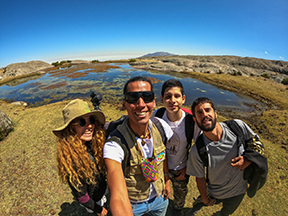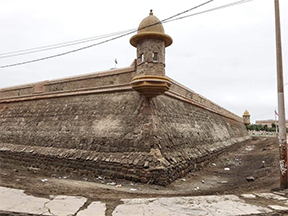|
WHO: Pre-tenure faculty from underrepresented ethnic and racial backgrounds at U.S. academic institutions, who study issues related to climate change and agriculture, aquaculture, or food insecurity. We encourage applications from varied disciplines in social and natural sciences and engineering. WHERE: Fellows are required to participate in two in-person, weeklong workshops held in January and July, as well as five virtual trainings throughout the year. Lodging expenses for the in-person workshops are pre-paid. Travel and per diem will be reimbursed. WHEN: Apply by September 23, 2024. The 2025 Fellowship runs January-December, 2025. WHY: Access mentorship, peer community, resources, new networks, and the skills and confidence to communicate your work and its impact to the world. Level up in your storytelling – and your career – while learning how to craft a more compelling tenure narrative that communicates the value of science communication. Fellows receive a stipend of $5,000 for their commitment, split in two payments after the in-person workshops. The SciComm Identities Project is supported by the National Science Foundation under Grants DRL-2115971 and DRL-2115522. Any opinions, findings, and conclusions or recommendations expressed in this material are those of the authors and do not necessarily reflect the views of the National Science Foundation. |
Category Archives: Classes
Knight Center Documentary Grant competition for 2024
The Knight Center for Environmental Journalism will award up to 3 grants of $3,500 each to support the making of environment-related documentaries (video, audio or other digital media) by MSU faculty-student teams.
Here are the essentials
Deadline for submission: February 16, 2024, at 5 p.m.
Decisions to be announced approximately March 8, 2024.
Open to faculty and students from all departments at MSU.
Maximum award: $3,500 for 1 year.
These must be documentaries, not public service announcements or advocacy pieces.
The Knight Center for Environmental Journalism must be credited for underwriting the project.
The Knight Center will be entitled to use your documentary, including linking on our website and presentation in classes, workshops and other activities.
Allowable expenses include travel, essential equipment, supplies, pay for students and festival & competition entry fees. All expenditures must comply with MSU procedures and rules. Any equipment purchased remains the property of MSU. Grant funds must be expended with one year from the date of approval by MSU Contracts and Grants.
What to Submit:
- Working title
• Medium: video, audio or other digital media
• Project summary (200 words maximum): What compelling story will you tell?
• Estimated timeline (Be realistic)
• Most likely audiences: Whom do you expect to watch or listen to it?
• For video & audio documentaries, what length do you expect the final version to be?
• Distribution plans: How will you disseminate your product?
• Budget plan: How do you plan to spend the money?
• Team members:
• Faculty: name, rank and department or school and project role, with abbreviated CV
• Students: name, year, major and project role, with resume
• Potential problems and obstacles
• Links to any relevant projects by team members or bring a CD to the Knight Center office at 382 Com Arts Building by the deadline
Email questions to Eric Freedman, Director, freedma5@msu.edu
Email submissions to Barbara Miller, mille384@msu.edu
The Fifth Modern Wonder of Peru
The Knight Center for Environmental Journalism recently taught an online environmental journalism to a group of university students in Peru. This is one of the stories produced during that effort. The program was funded by the U.S. Embassy in Lima.
By Alvaro Benavente
Six hours from Lima, three buses and four hours of walking — depending on your physical performance – is the fifth modern wonder of Peru, Marcahuasi.
 Located near the town of San Pedro de Casta in the province of Huarochirí, Lima, it is one of the highest plateaus in the world (4,100 meters above sea level), with 4 square kilometers of rock formations, spectacular abysses, lagoons, flora, fauna and a sky in which you can see the Milky Way.
Located near the town of San Pedro de Casta in the province of Huarochirí, Lima, it is one of the highest plateaus in the world (4,100 meters above sea level), with 4 square kilometers of rock formations, spectacular abysses, lagoons, flora, fauna and a sky in which you can see the Milky Way.
Without a doubt, it’s quite a visual show known among the hikers of Peru. Continue reading
Dismissed Relics: Real Felipe Fortress
The Knight Center for Environmental Journalism recently taught an online environmental journalism to a group of university students in Peru. This is one of the stories produced during that effort. The program was funded by the U.S. Embassy in Lima.
By Micaela Sotillo
Peru is a country with monuments of great historical value, and for every street or avenue you walk, there will be something to tell about it.
The huacas, temples and fortresses are located inside and outside the cities, giving an effect of mysticism to the neighborhoods.
In the Callao region, known for being the largest seaport since the viceroyalty, there is the Real Felipe Fortress. It is the most fascinating attraction of the port of Callao.
Built in the 18th century, the Real Felipe defended Lima from pirate attacks, and the strong walls continued to protect the city even after independence in the 19th century.
 This wonderful monument is the pride of many citizens of the region.
This wonderful monument is the pride of many citizens of the region.
However, a few weeks ago, many citizens registered complaints about the poor condition and maintenance outside the installations. Between plastic bags and organic waste, the foundations are deteriorating, and what seemed like a place admired by many is now a concern for history lovers. Continue reading

 WHAT: A year-long fellowship developed by University of Rhode Island’s
WHAT: A year-long fellowship developed by University of Rhode Island’s